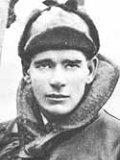|
Edward
Mannock


Name: Edward
Corringham "Mick" Mannock
Country: British Isles
Rank: Major
Service: Royal Flying Corps
Royal Air Force Units: 40, 74, 85
Victories: 61
Date Of Birth: 24 May 1887
Place of Birth: Ballincollig, Co.
Cork
Date Of Death: 26 July 1918
Place of Death: Near Lestrem
When the war began, Mannock was interned in Turkey while
working as an inspector for a British telephone company. After an
unsuccessful escape attempt, he became deathly ill and was
repatriated by the Turks in 1915. When he recovered, he joined the
Royal Army Medical Corps before transferring to the Royal
Engineers. Despite a congenital defect that left him virtually
blind in his left eye, Mannock was accepted by the Royal Flying
Corps in 1917, training under the scrutiny of James McCudden.
In April, he was assigned to 40 Squadron where he got off to a
slow start with his peers and his Nieuport scout. To the other
flying officers, he seemed aloof and perhaps overly cautious in
the air. It was not until a month later that he scored his first
victory by flaming an enemy balloon. Eventually, Mannock earned
the respect and friendship of men like Keith Caldwell.
In February of 1918, he was reassigned to 74 Squadron as a
flight commander, scoring thirty six victories with an S.E.5a
before replacing William Bishop as the commanding officer of 85
Squadron on July 3, 1918. Mannock never achieved the public
notoriety of Albert Ball, but he was revered by his men and proved
to be one of the greatest flight leaders of the war. Often
physically ill before going on patrol, Mannock routinely shared
victories with other pilots or didn't bother submitting claims for
enemy aircraft he'd shot down in combat. After selflessly sharing
his 61st victory with Donald Inglis, a newcomer from New Zealand
who had yet to score, Mannock was killed when his aircraft was
shot down in flames by machine gun fire from the ground. Inglis
was also brought down by ground fire but survived. On August 12,
1917, Mannock shot down and captured Joachim von Bertrab of Jasta
30. Mannock was credited with 46 victories while flying the
S.E.5a. On July 18, 1919, it was announced that Mannock had won
the Victoria Cross.
|
